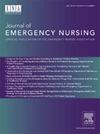泰国急诊科对护士的工作场所暴力行为因素的综合评价
IF 2.3
4区 医学
Q2 EMERGENCY MEDICINE
引用次数: 0
摘要
卫生保健环境中的工作场所暴力,特别是在急诊科,是全世界关注的一个重大问题。作为第一线的急救护士受到身体和心理暴力的影响。本综合综述旨在综合泰国急诊科中导致工作场所暴力因素的文献。方法:采用Whittemore和Knafl的框架进行研究。搜索策略使用了7个数据库,包括PubMed、CINAHL、ERIC、PsycINFO、MEDLINE、谷歌Scholar和ThaiJo,涵盖了2014年至2024年的文章。最终综述纳入了11项研究。数据被提取为个人、患者、环境、组织和泰国文化因素。结果:工作经验不足10年的护士发生工作场所暴力的风险较高。与病人有关的因素,如药物滥用和精神分裂症、双相情感障碍和严重抑郁症等精神健康状况,是造成暴力的重要因素。过度拥挤、人员不足和缺乏安全措施等环境因素加剧了这种风险。组织问题,如程序和报告制度不足,增加了暴力,因为缺乏报告机制使暴力得不到解决,恶化了工作场所的安全。泰国的文化因素,如缺乏对患者筛查严重程度的了解,导致了工作场所暴力的复杂性。讨论:解决泰国急诊科的工作场所暴力问题需要采取多方面的办法,包括政策改革、工作人员培训、改善安全和文化敏感性。有效的干预措施可以为护士带来更安全的工作环境,并改善对病人的护理。本文章由计算机程序翻译,如有差异,请以英文原文为准。
An Integrative Review of Factors Contributing to Workplace Violence Against Nurses in Thai Emergency Departments
Introduction
Workplace violence in health care settings, especially in emergency departments, is a significant concern worldwide. Both physical and psychological violence affect emergency nurses as frontliners. This integrative review aimed to synthesize the literature on the factors contributing to workplace violence in Thai emergency departments.
Methods
This study was conducted using Whittemore and Knafl’s framework. A search strategy used 7 databases, including PubMed, CINAHL, ERIC, PsycINFO, MEDLINE, Google Scholar, and ThaiJo, covering articles from 2014 to 2024. Eleven studies were included in the final review. Data were extracted into individual, patient, environmental, organizational, and Thai cultural factors.
Results
The results suggested that nurses with less than 10 years of experience had a high risk of workplace violence. Patient-related factors, such as substance abuse and mental health conditions such as schizophrenia, bipolar disorder, and severe depression, were significant contributors to violence. Environmental factors such as overcrowding, understaffing, and a lack of security measures exacerbated the risk. Organizational issues, such as insufficient procedures and reporting systems, increased the violence, given that the lack of reporting mechanisms allowed violence to go unaddressed, worsening workplace safety. Cultural factors in Thailand, such as a lack of understanding of patient screening severity, contribute to the complexity of workplace violence.
Discussion
Addressing workplace violence in Thai emergency departments requires a multifaceted approach, including policy reforms, staff training, improved security, and cultural sensitivity. Effective interventions can lead to safer working environments for nurses and improved patient care.
求助全文
通过发布文献求助,成功后即可免费获取论文全文。
去求助
来源期刊
CiteScore
3.10
自引率
11.80%
发文量
132
审稿时长
46 days
期刊介绍:
The Journal of Emergency Nursing, the official journal of the Emergency Nurses Association (ENA), is committed to the dissemination of high quality, peer-reviewed manuscripts relevant to all areas of emergency nursing practice across the lifespan. Journal content includes clinical topics, integrative or systematic literature reviews, research, and practice improvement initiatives that provide emergency nurses globally with implications for translation of new knowledge into practice.
The Journal also includes focused sections such as case studies, pharmacology/toxicology, injury prevention, trauma, triage, quality and safety, pediatrics and geriatrics.
The Journal aims to mirror the goal of ENA to promote: community, governance and leadership, knowledge, quality and safety, and advocacy.

 求助内容:
求助内容: 应助结果提醒方式:
应助结果提醒方式:


